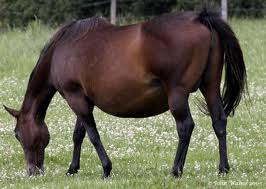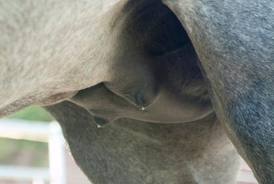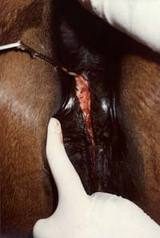Management of the Pregnant Mare
Gestation Length The average gestation length of a pregnant mare is 335 to 340 days, but can range from 320 to 370 days. There may be much variability among mares, but most individually follow similar patterns year after year. Foals are considered premature if delivered at less than 326 days of gestation and usually require immediate veterinary attention. Mares foaling before 310 days are considered to have aborted. Many breeders will calculate the expected foaling date at 11 months following the last breeding date. Most mares will gestate longer than 11 months, however, this allows for fewer "surprise" foalings in undesirable conditions.
 There are various traits which can influence length of a mare's pregnancy. Studies have shown colts tend to gestate 2 to 7 days longer than fillies. The nutritional plane of a pregnant mare also has been shown to have some influence on gestation length. Additionally, mares foaling during the late spring and summer months (long days) tend to have a shorter gestation length than those foaling in January or February. Exposure of bred mares to artificially lengthened days during the latter third of gestation has been shown to shorten gestational length by about 10 days.
There are various traits which can influence length of a mare's pregnancy. Studies have shown colts tend to gestate 2 to 7 days longer than fillies. The nutritional plane of a pregnant mare also has been shown to have some influence on gestation length. Additionally, mares foaling during the late spring and summer months (long days) tend to have a shorter gestation length than those foaling in January or February. Exposure of bred mares to artificially lengthened days during the latter third of gestation has been shown to shorten gestational length by about 10 days.
Early Signs of Foaling ...Waxing Teats The signs of impending parturition are about as variable as gestation length. Although there is a tremendous amount of variation among pregnant mares, many individuals do repeat their foaling behavior year after year. Therefore, it is recommended to keep accurate records on each mare to aid future deliveries.
 The classical signs of approaching parturition include udder development beginning 2 to 6 weeks before foaling, then milk let down into the teats (teat distension) 4-6 days prior to parturition. Due to oozing out of some of the colostrum, the ends of the teats become covered over and the mare is said to be "waxing", which occurs 1-2 days before foaling. At this time, some mares will have occasional dripping or streaming of colostrum. It this streaming is continuous, the colostrum should be collected and stored for possible use with the newborn foal. In addition to changes associated with the mammary gland, muscular relaxation in the pelvic region occurs progressively during the last 7-14 days of gestation and the pregnant mare's vulva begins to relax during the final days of gestation.
The classical signs of approaching parturition include udder development beginning 2 to 6 weeks before foaling, then milk let down into the teats (teat distension) 4-6 days prior to parturition. Due to oozing out of some of the colostrum, the ends of the teats become covered over and the mare is said to be "waxing", which occurs 1-2 days before foaling. At this time, some mares will have occasional dripping or streaming of colostrum. It this streaming is continuous, the colostrum should be collected and stored for possible use with the newborn foal. In addition to changes associated with the mammary gland, muscular relaxation in the pelvic region occurs progressively during the last 7-14 days of gestation and the pregnant mare's vulva begins to relax during the final days of gestation.
Many pregnant mares will show these "classical" signs of approaching parturition and make it fairly easy to determine their foaling time. On the other hand some mares will break all the rules and these signs may not be present, or may appear at varied times.

Preparations for foaling ...Caslicks removal Early in gestation, some mares require a Caslicks operation to partially suture together the lips of the vulva. Caslicks are used to prevent problems in mares that have abnormal vulva conformation. Pregnant mares that have a Caslicks must have the lips of the vulva opened at least 30 days prior to foaling. If the Caslicks is not opened, there is a possibility of oblique tears to the vulva or vagina which are difficult to repair and may result in a deformity that leads to uterine infection.
|
 There are various traits which can influence length of a mare's pregnancy. Studies have shown colts tend to gestate 2 to 7 days longer than fillies. The nutritional plane of a pregnant mare also has been shown to have some influence on gestation length. Additionally, mares foaling during the late spring and summer months (long days) tend to have a shorter gestation length than those foaling in January or February. Exposure of bred mares to artificially lengthened days during the latter third of gestation has been shown to shorten gestational length by about 10 days.
There are various traits which can influence length of a mare's pregnancy. Studies have shown colts tend to gestate 2 to 7 days longer than fillies. The nutritional plane of a pregnant mare also has been shown to have some influence on gestation length. Additionally, mares foaling during the late spring and summer months (long days) tend to have a shorter gestation length than those foaling in January or February. Exposure of bred mares to artificially lengthened days during the latter third of gestation has been shown to shorten gestational length by about 10 days.  The classical signs of approaching parturition include udder development beginning 2 to 6 weeks before foaling, then milk let down into the teats (teat distension) 4-6 days prior to parturition. Due to oozing out of some of the colostrum, the ends of the teats become covered over and the mare is said to be "waxing", which occurs 1-2 days before foaling. At this time, some mares will have occasional dripping or streaming of colostrum. It this streaming is continuous, the colostrum should be collected and stored for possible use with the newborn foal. In addition to changes associated with the mammary gland, muscular relaxation in the pelvic region occurs progressively during the last 7-14 days of gestation and the pregnant mare's vulva begins to relax during the final days of gestation.
The classical signs of approaching parturition include udder development beginning 2 to 6 weeks before foaling, then milk let down into the teats (teat distension) 4-6 days prior to parturition. Due to oozing out of some of the colostrum, the ends of the teats become covered over and the mare is said to be "waxing", which occurs 1-2 days before foaling. At this time, some mares will have occasional dripping or streaming of colostrum. It this streaming is continuous, the colostrum should be collected and stored for possible use with the newborn foal. In addition to changes associated with the mammary gland, muscular relaxation in the pelvic region occurs progressively during the last 7-14 days of gestation and the pregnant mare's vulva begins to relax during the final days of gestation. 
